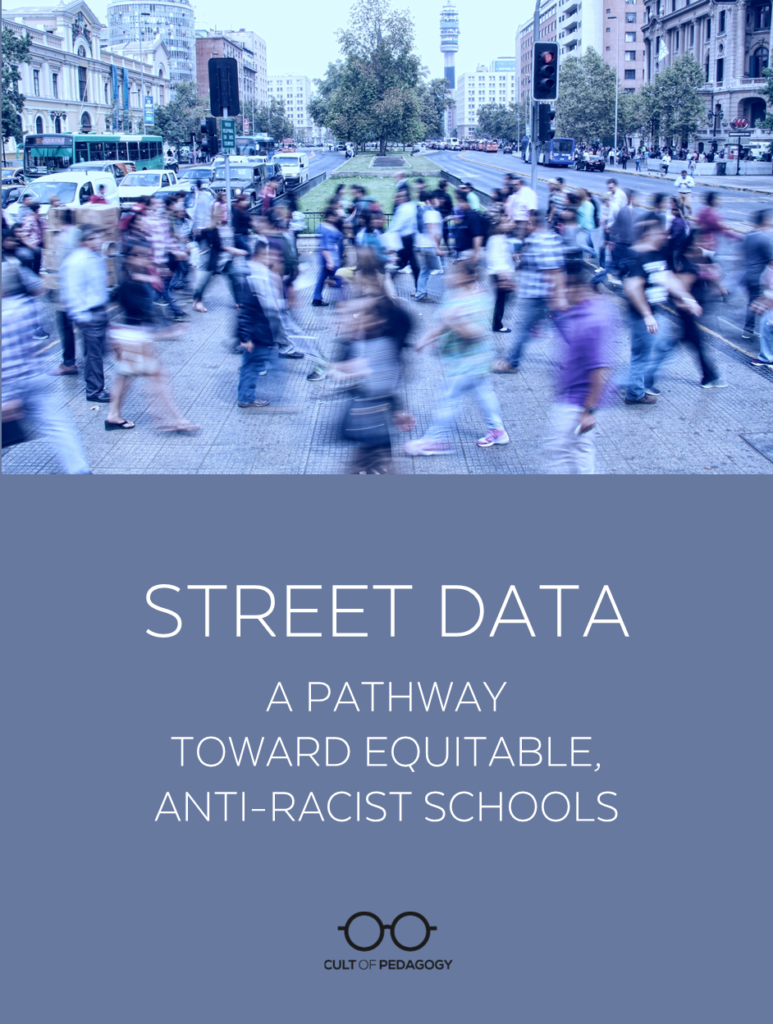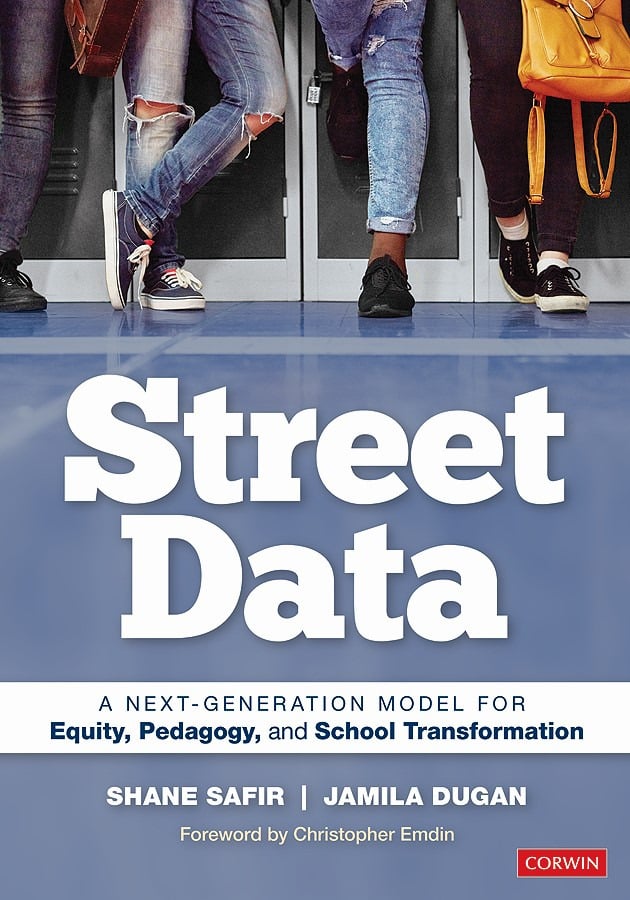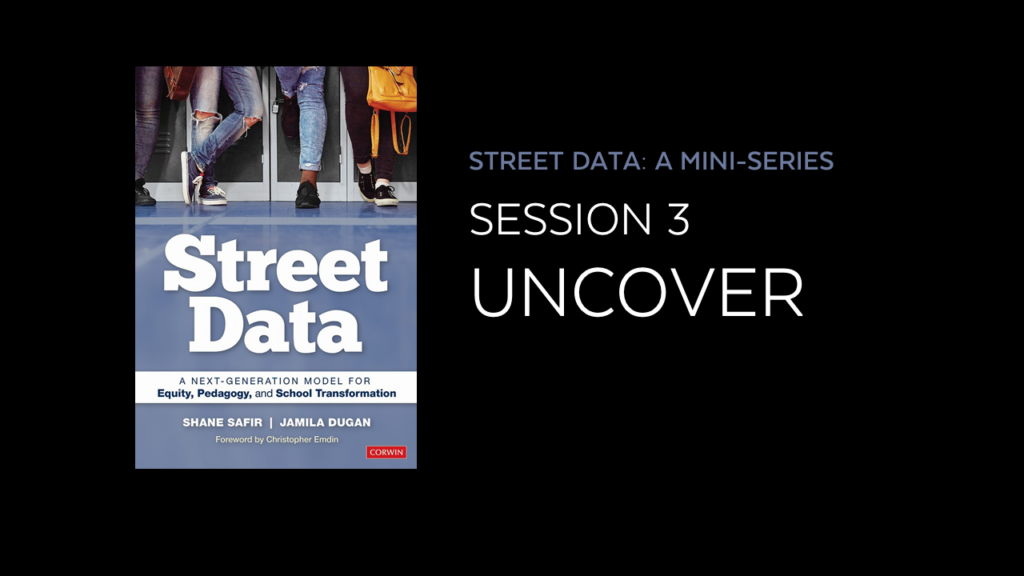
Listen to the interview with Shane Safir and Jamila Dugan (transcript):
Sponsored by CommonLit and ISTE
This post contains Amazon Affiliate links. When you make a purchase through these links,
Cult of Pedagogy gets a small percentage of the sale at no extra cost to you.
We’re living in a time in history when awareness of educational inequality has risen to what seems like its highest point ever, and many good resources have emerged to help us attack the problem from multiple angles: anti-bias training, book studies, restorative practices, culturally responsive teaching, improving representation in our classroom materials, the list goes on. Unfortunately, many of these resources only chip away at the problem, and many are only being consumed by individual teachers or served up as one-off trainings whose impact ultimately fades after a period of time. These efforts, while well-intended, often don’t make enough of a difference because we’re trying to make them work inside a system that’s a terrible fit for them.
What’s been missing is a whole-school approach, something that completely shifts our focus and creates a path forward that is radically different from what we’ve done before.
Earlier this year, a book came out that I think fills that void. It’s called Street Data: A Next-Generation Model for Equity, Pedagogy, and School Transformation. Written by Dr. Shane Safir and Dr. Jamila Dugan, the book outlines an approach to school improvement that focuses on a completely different kind of data analysis. Instead of looking at grades and test scores, attendance and graduation rates, the Street Data method looks at data from the ground up, where educators and school leaders act as ethnographers to gather stories, artifacts, and observations from the margins: the families, students, and educators themselves. It is not a silver bullet. It is not a quick fix. The Street Data approach is messy, it’s different for every school, and it is never “done.” But in the 20-plus years that I have been teaching or teaching about teaching, I have never seen an approach that I thought was more promising.
On the podcast, I talked with Safir and Dugan about what schools have done historically to address equity gaps, why those efforts have largely failed, and why their approach is far more effective. Below is a summary of our conversation.
Why Most School Improvement Efforts Fall Short…
Since the passing of the No Child Left Behind Act, U.S. schools have tried desperately to improve the test scores of students whose performance fell below proficiency. Many of these efforts haven’t succeeded—at least, not to the degree school leaders hoped. They also created a test-obsessed culture in schools that put instructional emphasis on drill-and-kill test prep, then punished teachers when all that prep didn’t produce the desired results.
The problem, Safir and Dugan submit in their book, is that schools have been focusing on the wrong data—satellite data—the kinds of numbers we can only see from a distance, like test scores, graduation rates, and so on.
“The achievement gap itself is a mythology,” Safir says. “It’s a distortion. And it’s rooted in a really narrow epistemology or sense of what it means to know.”
In other words, we’re measuring the wrong things, defining achievement through a lens that’s way too limited. “Those measures are pretty disconnected from our day-to-day,” Dugan says. “In this model, student work gets skipped over. I can’t tell you the amount of times I go in a classroom going like, oh my gosh, you’re not even looking at the work. You’re just looking at the test.”


…and Well-Meaning Equity Efforts Miss the Mark
At the same time schools have attempted to boost academic achievement via testing, they’ve also been taking action to improve equity through one-and-done professional development, new hires, or abrupt policy changes—a collection Dugan refers to as Equity Traps and Tropes. Unfortunately, these efforts often produce disappointing results, not because they aren’t well-intended, but because they are treated as to-do items that ultimately don’t change the larger system.
“It’s not a destination,” Dugan says. “Equity is much more a journey. It’s dynamic. You don’t just achieve equity at a moment. And if you did, you’d be shifting the next moment because it’s a dynamic process. So I can’t just say, All right. We know research says we need more staff of color. So I hire staff of color, then I’m done. Or We know we want to have a restorative justice lens. We want to have restorative practice. So we do a PD on that. Good, we’re done. We do culturally responsive teaching. We’re done. So now we’re equitable.”
All this hard work—the test prep, the data analysis, the equity trainings—has been done by people who really wanted to see all students achieve, be happy, live good, productive lives, and yet it hasn’t made nearly the difference they hoped it would. If we want students to be successful, if we want to truly leave no child behind, we need a new definition of success.
That’s where Street Data comes in.
How Street Data Is Different
The Street Data model is built around these key characteristics:
Data Collection is Holistic and Ground-Level
The model works from the ground up, assessing how a school is doing by going directly to the students, teachers, parents, and community members who are directly impacted. Through a process of deep listening, observation, and the study of artifacts (student work, videos, etc.), data is gathered, studied, and explored.
The authors define it this way in the book: “Street data are the qualitative and experiential data that emerges at eye level and on lower frequencies when we train our brains to discern it. These data are asset based, … helping educators look for what’s right in our students, schools, and communities instead of seeking out what’s wrong” (p. 57).
With that data in hand, all stakeholders co-design a path forward, building something that meets the unique needs of their learning community with the unique assets of that community. This is what makes the Street Data approach so special: It’s not a one-size-fits-all “program” that all schools can follow for improvement; it’s a method for study and reflection that will give every school a customized solution, one that will keep evolving over time.
Agency Is the Goal
A thread that runs throughout the Street Data approach is agency, “the idea that people have the capacity to take action, craft and carry out plans, and make informed decisions based on a growing base of knowledge” (p. 229).
This idea plays out first in who is involved in the data collection process. Rather than it being a top-down approach, Street Data is practitioner-driven, giving teachers the role of researchers.
Agency also holds a central place in the pedagogy envisioned by the authors. “At the heart of this book is this guiding principle that equity work is first and foremost pedagogical,” Safir explains, “that what it means to work toward equity begins and, in some ways, ends in the classroom.”
Specifically, this is a pedagogy that gives students the tools “to become agents of their own learning and ultimately agents in the world.” This means an emphasis on student voice, project-based and inquiry-based learning, portfolio development and defense, and assessment practices that value feedback and revision over grades.
Anti-Racism Is the Driver
Both authors are firm on this point: The driving force behind the Street Data approach is anti-racism, a commitment to taking direct and sustained action to uproot systemic racism and reduce racial inequality.
“This model is not neutral,” Safir says. “We’re not trying to play a game of neutrality or to say that the history of systemic racism isn’t relevant here. We have to be explicitly anti-racist as we pursue this path of street data. And we have to be willing to disrupt the narratives and the practices and the biases that are continuing to marginalize students.”
Our current system “has long promoted the myth that students of color ‘need developing’—translated: Black, Indigenous, and brown students are broken and schooling will fix them. To walk the next-generation path of street data, we have to be vulnerable enough to reject this racist lie and stare down the parts of our own practice that need to be fixed” (p. 52).
This brief summary only scratches the surface of how Street Data works. For schools to adopt this model well, the starting point is to read the book, which goes into much more detail about how to implement it. To get support, professional development is available by contacting either author through their websites, which are listed below.
I can’t count how many books have been written over the past few decades about school transformation, and many of them probably have some very good ideas, but I have never once reviewed any of these books here, because none of them had an overall approach that seemed as promising as this one. We all want our schools to do better; I think Street Data could very well be the best way to get there.
Learn More
Find Shane Safir at shanesafir.com or on Twitter at @shanesafir.
Find Jamila Dugan at jamiladugan.com or on Twitter at @jamiladugan.
Street Data is Now a Podcast!
The Street Data Video Series
In 2023, we released a video series documenting the work of educators from two schools as they followed the Street Data protocol. Learn more about the series here.
Join our mailing list and get weekly tips, tools, and inspiration that will make your teaching more effective and fun. You’ll get access to our members-only library of free downloads, including 20 Ways to Cut Your Grading Time in Half, the e-booklet that has helped thousands of teachers save time on grading. Over 50,000 teachers have already joined—come on in.








I appreciate this holisitic approach to giving our students voice, project based and inquiry based learning and agree it is how we engage students and give them agency. I appreciate your perspective of marrying equity work with standards and units.
As a teacher and researcher of heritage language education, this episode resonated with my current work in incredible ways. As I dive into my interviews analysis with educators of Spanish as L2 with heritage language students in their classrooms, I observe once and again how the lack of integration of students’ voices and leadership in their own classes lays foundations of linguistic and cultural discrimination hidden under layers of good intentions. Thanks so much for your amazing work!
Marta, you make a good point. The more we get to know our students and their cultures, the less likely we are to unintentionally reinforce negative stereotypes. On a different note, we’re so glad you’re finding value in our resources!